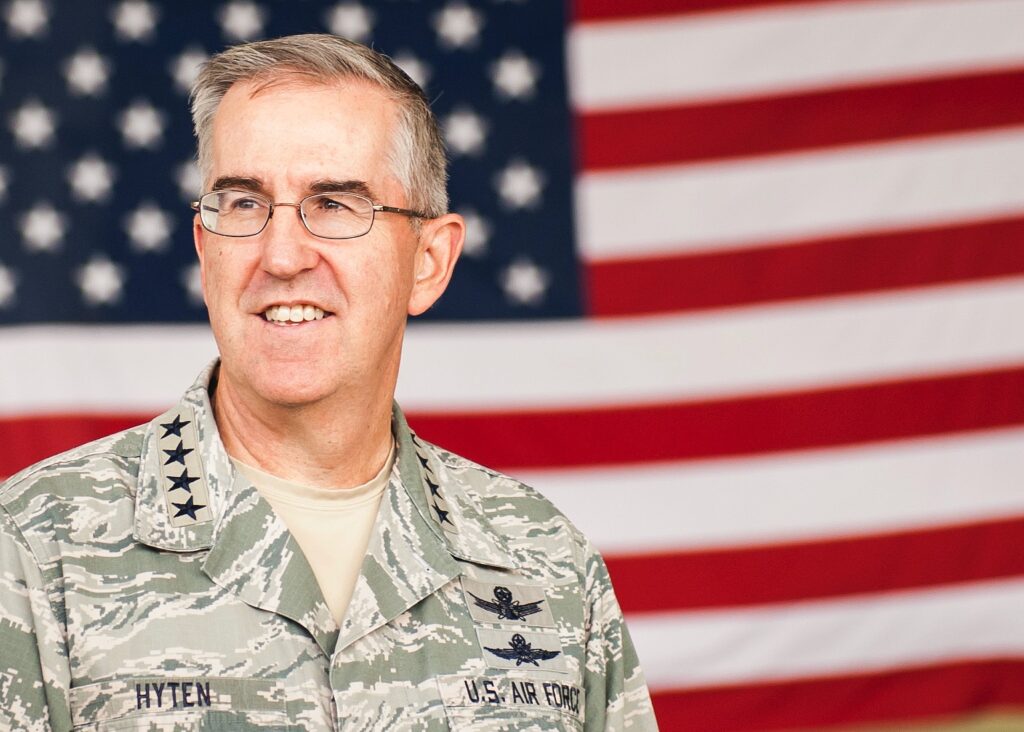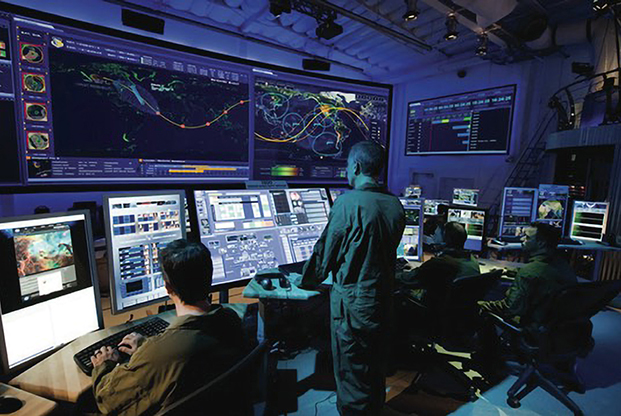By COLIN CLARK
 This is the first in a series of in-depth stories and interviews with senior defense officials about the future of the American way of war and a concept now known as All-Domain Operations. It’s a vision of a computer-coordinated fight across land, sea, air, space, and cyberspace, with forces from satellites to foot soldiers to submarines sharing battle data at machine-to-machine speed. We hope this series will help educate Capitol Hill, the public, our allies, and much of the US military itself on an idea that’s increasingly important but is still poorly understood. Why do so many of the Pentagon’s most senior leaders care so much about this? Read on — The Editor.
This is the first in a series of in-depth stories and interviews with senior defense officials about the future of the American way of war and a concept now known as All-Domain Operations. It’s a vision of a computer-coordinated fight across land, sea, air, space, and cyberspace, with forces from satellites to foot soldiers to submarines sharing battle data at machine-to-machine speed. We hope this series will help educate Capitol Hill, the public, our allies, and much of the US military itself on an idea that’s increasingly important but is still poorly understood. Why do so many of the Pentagon’s most senior leaders care so much about this? Read on — The Editor.
PENTAGON: No one who knows Gen. John Hyten would expect him to resort to hyperbole or bombast. Sitting beside me in his E-Ring office, the Vice-Chairman of the Joint Chiefs is, as always, focused and careful in his words. So when he told me that All-Domain Operations is “the biggest key to the future of the entire budget,” I had to ask him to repeat what he said. He explained its importance this way.
“Because if we figure that out, we’ll have a significant advantage over everybody in the world for a long time, because it’s the ability to integrate and effectively command and control all domains in a conflict or in a crisis seamlessly — and we don’t know how to do that,” Hyten told me. “Nobody knows how to do that.”
All-Domain Operations, he went on, combines “space, cyber, deterrent, transportation, electromagnetic spectrum operations, missile defense — all of these global capabilities together … to compete with a global competitor and at all levels of conflict.”
That will require not only new technologies but new concepts.Breaking Defense readers have seen these ideas evolve rapidly over the last few years, with even the terminology becoming ever more ambitious, from Multi-Domain Battle to Multi-Domain Operations to All-Domain Operations.
Defense Secretary Mark Esper is directly involved, having ordered the four services and the Joint Staff last fall to create a new Joint Warfighting Concept for All-Domain Operations by December. “That Joint Warfighting Concept will describe the capabilities and attributes necessary to operate in this future all-domain world,” Hyten explained.
“This concept is air, land, sea space, cyber, spectrum, everything that we need to operate in the future,” Hyten said. “The biggest difference, honestly, is the addition of space and cyber, because space and cyber have two different commanders who will be operating in those two domains in any crisis or conflict” — that is, the chiefs of Space Command and Cyber Command, whose global responsibilities overlap those of the theater Combatant Commanders who traditionally coordinate air, sea, and land operations in specific regions.
This thinking is all “deeply rooted” in the National Defense Strategy, released in 2018, Hyten emphasized. “The last chairman” — Gen. Joe Dunford — “embraced this as a concept,” he said. “General Milley now has expanded that.”
Dunford began with the idea of global force management, a new perspective that looked across traditional jurisdictional divisions between theater commands. He soon added the idea of global fires, weapons both physical (missiles) and non-physical (cyber attacks) that could be launched from outside a theater of war to have effects within it.
Gen. Milley added four new elements: global plans, not just traditional deliberate planning for set scenarios but rapid crisis response; global operations short of fires, that is, everything the military can do in the so-called “grey zone” between peace and open war; global integration of messaging, the deliberate use of both words and actions to reassure allies and deter adversaries; and global integration of deterrence, the use of all means, not just nuclear, to make potential enemies think twice about attacking.
“Believe it or not, we’ve learned a lot about global force management, but in the other areas, we’re still in the learning phase,” Hyten said. “One of the reasons we’re in a learning phase is because we don’t have an ability to do all-domain command and control yet.”
Hence the crucial importance of a key effort launched last year by the senior leadership, coordinated by the Joint Staff, and led by the Air Force: Joint All-Domain Command and Control (JADC2). Breaking D readers know more about this because we’ve covered as much of its evolution as possible. It is a concrete effort to build sensors, communications systems, and data fusion engines designed to make it possible for, say, a submarine, a Marine Corps infantry squad, an F-35, an Apache gunship, a P-8 patrol plane, an orbiting satellite or a Navy ship to feed targeting data to any other weapon to ensure the most efficient and lethal response to a threat.
It’s a bold approach, one that takes what the US military calls jointness to a new level. Before, each service trained, equipped and provided troops, who then worked together in battle. Organizations such as the Joint Staff and regional combatant commanders tied them together to ensure that troops and their communications and weapons systems could work together and were, at least, compatible — in theory..
Hyten notes that the US has “figured out how to do integration of air, land and sea. We figured that out really well.” All-Domain Operations builds on that foundation, and to some degree it can be conducted even by existing organizations. It’s really “just an expansion of the combined arms problem to air, land and sea, plus space and cyber,” he said.

The National Space Defense Center (formerly the JICSpOC) at Schriever Air Force Base
“Now, we treat space and cyber differently,” the vice-chairman continued. But they have their own rules of engagement, their own forms of maneuver, their own ways of having an effect on the conflict, just like any other form of military power. “Space and cyber is a little bit different,” he admits, “but nonetheless, if you just look at the practical issues of what you’re trying to do, it’s just a combined arms command and control problem.”
To figure out how to do this much expanded combined arms approach, the US has done two major wargames, called Global Integration Exercises, modeling wars with Russia and China. (It wasn’t clear whether there was a single scenario involving both countries or two separate scenarios, one involving Russia by itself and the other China by itself).
“We’ve done two globally integrated exercises now, both built on top of [existing] combat and commander exercises, One in one part of the world, one in another part of the world, Hyten said. Which areas? “All you’ve got to do is read the NDS and you can figure that out,” he said. “These are global conflicts, [focused] around a certain part of the world, [but] involving all commands and all domains,
“As we look at those and we play it out, we find where the holes are, and oh my gosh, the holes are obvious and we don’t have the ability to [fill] them” — not with our current way of war, he said. “So the two globally integrated exercises that we’ve done so far and the one that we’re going to do this fall really, really do show the importance of this (All-Domain Operations) in the future.”
“These Global Integrated Exercises are enormously difficult to do, enormously expensive,” he said. “When you do it and you’re not fully successful [in the simulated conflict] — nobody that wears the uniform likes to show up at work and not do well. So it’s very powerful.”
After the interview, the Joint Staff told me that the Global Integration Exercise program was started in 2018 during Gen. Dunford’s tenure as CJCS.
“The intent is for GIE exercises to be a recurring opportunity for senior DoD leaders, COCOMs and the U.S. government interagency to exercise transregional, all-domain scenarios at the strategic level in support of the National Defense Strategy,” a statement from Hyten’s office explains. “Ultimately, these exercises enable the DoD to test and refine new concepts, reduce uncertainty, and increase readiness.”
“Planners tailor exercise scenarios to be intentionally transregional and all-domain, with the secretary, the chairman and the combatant commanders all participating,” the statement continues. The exercises also include the National Security Council, State Department, Intelligence Community and other elements of the federal government.
“The next one we’re going to do,” Hyten noted during our interview, “is actually going to be purpose-built from the beginning to involve everybody. That will be the most effective one.”
No other details were provided in the statement: “For operational security reasons, we will not discuss the details of specific GIE scenarios or exercise timelines.”
No comments:
Post a Comment